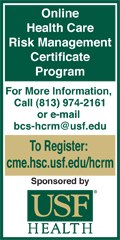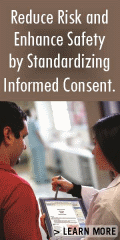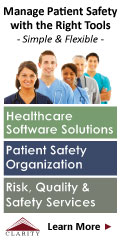 |
 |
 |

September / October 2005

Barcoding and RFID
Intelligent Location
By Mike Dempsey
As the buzz around the potential for radio frequency identification (RFID) in healthcare increases, so do the questions related to its practicality and payback. Answers vary because RFID represents an array of technologies, each with its own requirements and value for healthcare.
The focus of this article is active-RFID indoor positioning systems, or IPS — the indoor corollary to GPS — and its use in perioperative care at three unaffiliated hospitals.
Active-RFID IPS has been shown to streamline patient flow, improve equipment management and staff efficiencies, and deliver a return on investment in less than a year.
Where a GPS uses satellites above the earth, an active-RFID IPS uses compact receivers on a hospital's network. Active (battery-powered) tags are affixed to each person or thing to be tracked. These tags transmit a consistent signal over a long range, which makes them effective for identifying and locating people or items that move frequently and over large distance indoors.
Passive-RFID, the more commonly recognized technology, is also important in healthcare. Small and inexpensive, passive-RFID tags have no internal power and must be brought close to an antenna to be activated. Passive-RFID systems are effective for uniquely identifying things and people in controlled settings. For example, the technology might be used to identify and manage the inventory of narcotics or other expensive medications, or to secure the portal into a restricted clinical area.
For hospitals using active-RFID IPS to optimize surgical workflow and patient throughput, the ability to automatically know and use real-time patient location throughout the complex phases of surgery enables a smarter perioperative care environment: Clinicians achieve greater efficiencies, patients realize a better overall surgical experience, and waiting loved ones are engaged with relevant surgical status information.
Where Is My Mom?
On any given day in the surgery department at Mississippi Baptist Medical Center, people in the waiting area intently eye an overhead display "like people at an airport checking their flights," says Kempf Poole, director of surgical services. Here, the arrivals and departures on the screen are for the various stages of perioperative care. For the loved one wondering "Where is my mom?," the real-time status communicated from the display offers reassurance in a message block next to a patient identification number: "Surgery is progressing." "Patient is recovering and resting comfortably." "Patient is ready for discharge."
A similar scene plays out daily at Hannibal Regional Hospital in Missouri and Lancaster General Hospital in Pennsylvania — and increasingly in hospitals worldwide.
Where Is My Patient?
At each of these three hospitals, the same technology that connects family members to real-time data is used to immediately update an anesthesiologist, surgeon, or nurse on patient status. That data is then stored and available for analysis.
At a minimum, each hospital uses the patient location module of the workflow management solution to:
- Capture and analyze timing of significant clinical events

- Display the information so no one has to wait for or seek out updates

- Analyze the data to determine whether and why bottle-necks occur
An objective time-stamp for any defined event within the perioperative process — from when anesthesia begins to when the patient is ready for discharge — can be recorded automatically based on the patient (and therefore his or her active-RFID tag) changing location or by pushing one of the tag's buttons. This eliminates the need to take notes or to have a computer at that point of care, which saves time and increases record-keeping accuracy.
A Knowledge Base for Infection Control
A particularly compelling example is the use of active-RFID IPS to record the time an incision is made, the time the incision is closed, and the timing of antibiotic treatments. "Every hospital is faced with reducing the infection rate," says Judy Patterson, director of surgical services at Hannibal Regional. "By knowing how long a patient's incision is open, when antibiotics are administered, and the timing of other critical aspects of care, we are developing a knowledge base we can use as we work to reduce infection rates."
A common benefit of using RFID for these three hospitals is a reduction in the number of back-and-forth telephone calls and manual data entry that had been required to keep everyone informed of patient location and status.
Explains Stacey Youcis, assistant vice president for musculoskeletal and surgical services at Lancaster General: "We have reduced the time spent on clerical tasks, automating data capture to give clinicians the specific information they need to respond more quickly and appropriately. Whenever you enable more time and energy to be focused on patient care you effectively improve the quality of care."
How It Works
An active-RFID IPS enables patient, staff and equipment tracking applications for patients, staff, and equipment, and the use of each to accurately measure and adapt care processes. For patient location in perioperative care, an active-RFID tag can attach to a patient's wristband or to the IV bag that stays with the patient from admission to discharge. The signals from the tag combine with location analysis software to provide immediacy, accuracy, and intelligence, ensuring that clinicians and systems know and objectively record the who, what, when, and where of procedures, from "Patient XYZ in pre-op" to "Patient ready for discharge" and every step in between.
By recognizing and responding to when and where an active-RFID tag moves, the IPS initiates automatic actions, such as recording procedure start and stop in clinical applications or signaling appropriate personnel if the wrong patient is in the wrong procedure room.
The precise timing of clinical events essential for objectively measuring care processes is further enhanced with interactive buttons on active-RFID tags. The buttons are programmable to initiate actions based on the tag's location. For example, a hospital could define that in pre-op, pushing the first button records the time when anesthesia assumes care; pushing the second button, the time that the patient is ready for the OR. As the patient and his or her attached active-RFID tag move to the next stage of care, pushing the buttons might record the times when induction and closing begin.
As the time-stamps are recorded for analysis, real-time updates are sent to displays in waiting and clinical areas, or to pagers and cell phones — so families know how their loved ones are progressing, and clinicians and staff members know when and where they are needed.
Hannibal Regional Hospital: The Decision to Invest Pays Back within a Year
The 105-bed Hannibal Regional Hospital may seem an unlikely target for emerging technology. But for Judy Patterson, director of surgical services, the decision to invest in active-RFID became as clear as the mandate she received when she was hired — identify and fix broken processes.
Her decision paid off with a return on investment within the first year based on increasing OR utilization, reducing overtime, and improving inventory management.
"I wasn't out looking for an RFID solution. I didn't even know about RFID," recalls Patterson. "I just knew I wanted to improve the management of this environment. To achieve this I had to be able to accurately measure events. We were looking for a technology that would take us into the future. Active-RFID is that technology. You can't manage what you can't measure, and this solution lets us measure any part of any process."
Citing patient safety as a driver for all improvements, Patterson is open to measuring anything that she and the surgical staff believe can be improved, whether it's reducing the length of time a patient is exposed to infection or ensuring essential equipment is available when needed. Patterson says she reviews the workflow measures collected on a regular basis and as well as anytime a problem is brought to her or another manager's attention.
"The data is ours to use as we need," she says. "When a problem is identified, we can analyze processes objectively to determine what happened. Then we can make changes."
Hannibal Regional's goals are to increase room utilization, staff satisfaction, and clinical efficiency. The hospital is right on track. Patterson reports room utilization has increased to 70% from a previous 57%. The system also identified that 20% of outpatient procedures were being performed after hours, so the hospital implemented block scheduling to reduce excessive overtime and increase staff satisfaction.
"We will soon track epidural pumps used in the birthing unit. In the next phase we'll be tracking equipment more extensively," Patterson says. "We estimate a nurse can spend as much as 30 minutes a day searching for equipment. That's a lot of time not spent on direct patient care — not to mention the risks of not having the right equipment available at the right time."
Mississippi Baptist Medical Center: Off the Phone and on to Improved Care Processes
At this 564-bed medical center, Kempf Poole, director of surgical services, figures that an average of five telephone calls was required to communicate one simple message to the right person — from the room to the desk, a call to the physician's pager, initiating and answering the call back, a message into the lab, and a call to the waiting area to update family members, and so on. Multiply every potential message by the hospital's 12,000 surgical cases a year, and this director of surgical services was managing a communications quagmire.
"You know that game where one person whispers something in another's ear, and by the time the information gets to the last person, the facts are changed," asks Poole. "When every change in status requires a person to pass on the information, you have a greater potential for inaccuracies," and inaccurate data can cause delays and other problems.
Two weeks of tallying the number of calls on each shift in his department confirmed what Poole had sensed. In one of the eight-hour shifts he scrutinized, the surgical unit handled an unwieldy 1,600 calls.
The ringing has been toned down dramatically. "With active-RFID IPS as part of our workflow system, the patient's location is automatically updated when there's a change. No phone calls. No data entry. And it's very specific location data. We know that a particular patient is in Room 20, prepped and ready."
Mississippi Baptist's original goal was to reduce the number of phone calls related to patient status inquiries by 30 to 40%. Staff acceptance is so high and accuracy so consistent, Poole has raised his expectations for reducing calls to 60%.
"We definitely find a correlation between improved awareness and increased efficiencies," Poole notes. "Staff members regularly monitor the screens and take immediate action when needed. We've been able to reduce time between cases, be better prepared in each stage of our process for what is upstream, and improving efficiencies to the extent that we may be able to reduce length of stay.
"I've got surgeons coming up to me with new ways to use the time-stamped data," says Poole. "When that happens, you know you've got buy-in."
Lancaster General Hospital: Frontrunners for RFID in Healthcare
Lancaster General Hospital, (563 beds), was using radio frequency in support of workflow enhancements long before the current RFID buzz. A workflow management solution was first implemented in 1998 and is operational at three sites: Lancaster General's downtown location, which includes inpatient and outpatient ORs, and the perioperative areas of Lancaster General Health Campus, and Lancaster General Womens & Babies Hospital.
With the opening of the Lancaster General Orthopedic Center — 10 operating rooms, 42 inpatient beds, a pre- and post-operative care unit and post-anesthesia care unit dedicated to orthopedic patients — the hospital moved up to its third-generation RF technology: an active-RFID IPS integrated with the workflow management solution they've trusted for seven years. Earlier generations of the solution enabled the hospital to improve OR utilization to more than 85% from a previous 50%. The hospital was also able to reduce OR turnaround time by eliminating an entire step: the patient holding room.
Stacey Youcis, assistant vice president of musculoskeletal and surgical services, sees improved compliance and data completeness as major advantages for using an active-RFID IPS to time-stamp clinical events. "It's so easy to use, and the staff has completely bought into the value," says Youcis. "We know we're getting accurate patient data and greater specificity. It's good to know the patient is in the OR. It's even better to know the patient is in OR number 3."
Youcis reports that her team uses the system daily. "There are two distinct ways we use the information we collect: to improve the way we manage everyday operations and to manage workflow and efficiencies as part of performance improvements."
Team members can immediately tell where a patient is, improving readiness for each stage of care. "When you provide caregivers the tools that make it easier for them to do their jobs more efficiently, they have more time to focus on patient care, which generally creates a safer care environment," Youcis says. "Every piece of the perioperative process is important, but we have to think about the entire continuum, how the individual pieces and players work together, and how we manage the handovers from one stage of care to another, to ensure the highest quality of service." To get there, Lancaster General will move to active-RFID for the sites using earlier RF technologies, and Youcis anticipates the organization will add equipment tracking.
Summary
Healthcare organizations today recognize the need to streamline patient throughput and optimize capacity. In perioperative care, as in other hospital areas, bottlenecks can be linked to poor utilization, excessive overtime, unproductive downtime, and dissatisfied clinicians and patients. An active-RFID IPS as part of a perioperative workflow management solution can help hospitals improve real-time communications around patient surgical status, ensuring everyone involved in the process is able to keep track of patients through the complex phases of surgery. Equally important is the ability of an active-RFID IPS to time-stamp the "who, when and where" of procedures, ensuring administration has objective data to identify and fix efficiency issues. The same technology used for patient location can be used for staff and equipment location.
Mike Dempsey (mike.dempsey@radianse.com) is a founder and chief technology officer of Radianse in Lawrence, Mass. Prior to co-founding Radianse, he worked as a technical strategist for wireless solutions at Hewlett-Packard/Agilent Technologies (now Philips Medical Systems). Dempsey holds six patents in wireless medical device communications and has six more pending for indoor positioning. He served on the AHA's taskforce on medical telemetry, acted as chairman of the Service Rules Committee, and vice-chair of the frequency allocation committee. Dempsey received a special citation from the FDA for "exceptional initiative and leadership to protect the public health."
- SPECIAL SECTION:
Barcoding and RFID

|
 |
 |
 |


















|
 |



